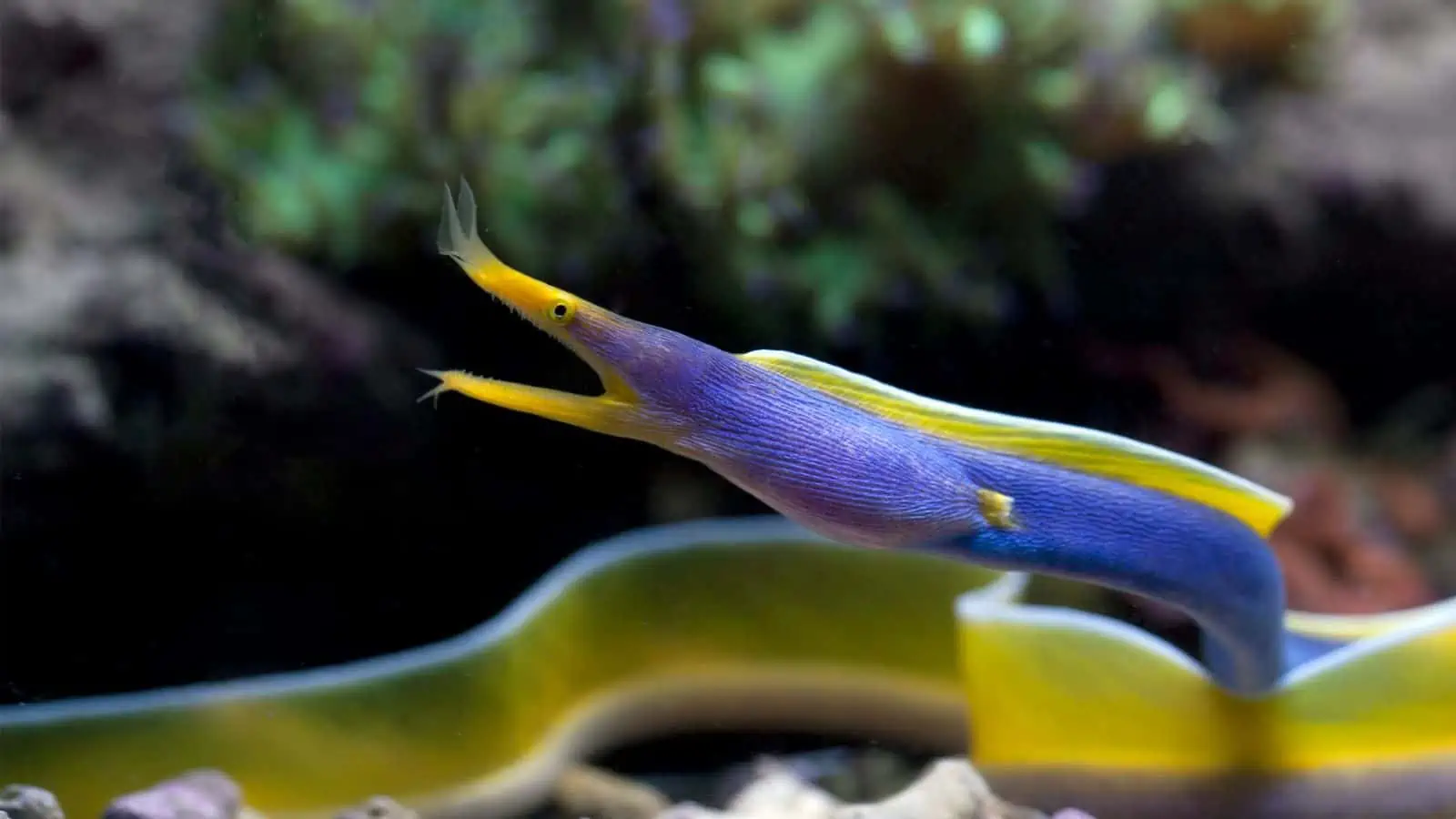The ribbon moray eel might look like a mythical dragon from a Chinese legend, but they also have one of the highest fatality rates of any fish in captivity.
Neale Monks, a renowned aquarium guru, rates the ribbon eel as probably the most difficult fish to keep alive in the entire aquarium trade.
Because 99% of them die within their first month in captivity, I’ve decided to write an article about why these beautiful fish are best left in their natural habitat, the sea.
Reasons Why Ribbon Eels Shouldn’t Be Kept in Home Aquariums
Ribbon Eels May Completely Refuse Food
One way that ribbon eels may express their discomfort with being kept in captivity is by refusing food.
By the time they’ve reached your fish tank, these secretive, oceanic creatures may have suffered so much stress and shock from being caught, transported, and placed in a small tank that they’ll refuse to eat altogether. Many if not most, starve to death from refusing food when they arrive in home aquariums.
Fish keepers can improve their chances of their ribbon eel accepting food by offering them copious hiding places (meaning you’ll see very little of your eel during the daytime!).
And even if they do eventually accept food – it has to be exactly the right kind of food, as we’ll now find out…
Ribbon Eels Need Live, Gut-Loaded Marine Fish To Stay Alive

Even if ribbon eels do begin to accept food, they’re incredibly picky eaters and need a meticulously planned menu to remain alive.
While other members of the eel family can survive on a mixed diet of frozen foods such as krill, squid, and small fish, the ribbon eel needs to be fed chiefly on live, gut-loaded marine fish to stay alive.
This means that you’ll need a constant supply of small marine fish like green chromis to feed them on at all times. Freshwater fish like guppies and goldfish simply won’t provide the right nutrients.
Unless you’re highly successful at breeding saltwater fish, you’ll need to buy small fish for them to eat, which could get very costly and time-consuming over the years, too!
Feeding Shrimp Causes Long-Term Poisoning in Eels
Some cunning fish keepers have tried to get around the live food problem by feeding their ribbon eels on live shrimp – which are certainly much easier to breed than marine fish!
The problem is that shrimp don’t contain the necessary nutrient profile to keep ribbon eels alive. Although shrimp may contribute as an occasional snack on the ribbon eels’ natural menu, these fish are primarily piscivores – most of their food should be fish.
Even though some fish keepers have had success keeping their ribbon eels alive for short periods on shrimp, it’ll prove fatal in the long run because shrimp contain a type of enzyme called Thiaminase that causes a lethal syndrome in eels.
By breaking down the thiamine (or Vitamin B1) in the eel’s body, Thiaminase causes thiamine deficiency. Common symptoms in eels include ‘trunk-winding syndrome’ and hemorrhages along the base of the fins.
To find out more about the dangers of thiaminase in fish diets, I recommend reading this excellent guide on the subject by Marco Lichtenberger.
Ribbon Eels Love To Escape From Tanks and Get Stuck in Filters!
Another reason that ribbon eels are notoriously difficult to keep is that they’re masterful escape artists!
While many fish species are adept at jumping out of fish tanks when the lid is removed, ribbon eels take escapism to the next level by wriggling out of any tiny gap in the tank’s structure or even through the plumbing!
It’s not unusual for these slender fish to get stuck in filter intakes or end up in the sump.
For such a precious pet, coming home to find your ribbon on the floor or smashed up by your aquarium filter would be nothing short of heartbreaking.
99% Of Ribbon Eels Die Within One Month in Aquariums

Given the high probability that ribbon eels will reject food, die from inadequate feeding, or get stuck in the tank plumbing, only around 1% of ribbon eels make it past their first few weeks in captivity.
If the first three causes don’t kill them, the stress from being kept in a captive environment might well.
Given the incredibly low chances of success, is it really worth shelling out top dollar for a precious marine fish that has such little chance of staying alive?
Besides, there are easier eels to keep!
There Are Easier Eels To Keep Than Ribbon Eels
Eels are fascinating fish to keep in aquariums, and thankfully there are some easier species to keep at home.
While most moray eels and conger eels get too big for the majority of home aquariums, another species known as the ‘snowflake moray’ or ‘(Echidna nebulosa)’ grows slowly to a mere 24 inches long, and is more robust than most other eels.
Snowflake morays are the most popular eel for saltwater aquariums because they’re also relatively peaceful and don’t tend to eat other fish (although they will sometimes eat crabs and shrimp!)
Still, all true saltwater eels are large, intelligent fish, and need plenty of expertise to keep alive – so even the snowflake moray is for advanced fish keepers with 75-gallon + marine tanks only!
If you’re serious about keeping saltwater eels, I’d highly recommend reading this brief piece of expert advice on the snowflake moray eel here.
Conclusion
It’s incredibly sad that most ribbon eels die within their first month of captivity. In most cases, it’s simply because the buyer didn’t realize how hard it is to keep these fish alive at home.
It’s my hope that with better information, fewer dealers will succeed in deceiving hobbyists into purchasing this misunderstood fish. Then ribbon eels will be able to live long and happy lives in the sea, where they belong.


